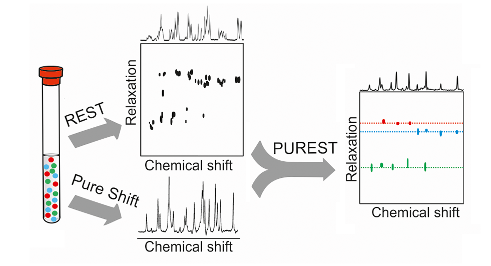- EUROMAR 2022
- GNAT 1.3 released
- JMR Young Scientist Award
- SMASH poster award
- Workshop on pure shift NMR
- Course in diffusion NMR at UNICAMP, Brazil
- GNAT - the General NMR Analysis Toolbox
- James N. Shoolery Award
- New version of the DOSY Toolbox
- Spotlight on PSYCHE
- Gareth Morris FRS
- JMR cover for The Varian Story
- More...
Pure Shift Relaxation Encoded Selective TOCSY
Summary:
Pure Shift Relaxation Encoded Selective TOCSY (PUREST) builds on the REST family of NMR experiments for mixture analysis allowing for the extraction of component subspectra from mixtures. It uses isotropic mixing to label whole spin systems with the relaxation times (e.g. T1, T2) of individual spins. Followed by a PSYCHE J refocussing element to remove the effects of homonuclear scalar coupling, (JHH), on the spectra.

Pulse sequence:
The basic structure of the pulse sequence consists of an initial generation of T1 or T2 relaxation-weighted single quantum coherence (either using the inversion recovery or PROJECT sequence, respectively); a selective 180o pulse to select signals at a single chemical shift; an isotropic mixing sequence (here DIPSI-2 with zero-quantum coherence suppression) to transfer coherence throughout each spin system; and a final PSYCHE J refocusing element to remove the effects of homonuclear scalar coupling on the spectra.

Downloads:
Bruker pulse programs::
PUREST1
PUREST2
Experimental data can be downloaded from
here.
Processing:
The processing of PUREST1 and PUREST2 experimental data is straightforward using the free and open source software package GNAT.
Reference:
Giving Pure Shift NMR Spectroscopy a REST ─ Ultrahigh-Resolution Mixture Analysis, M. Smith, L. Castañar, R. W. Adams, G. A. Morris, M. Nilsson. Analytical Chemistry, 2022, 94, 12757-12761. DOI: 10.1021/acs.analchem.2c02411
Please note that copyright restrictions prevent us from placing the pdf files on our website, however, this article is open access and the pdf can be downloaded from ACS website.
